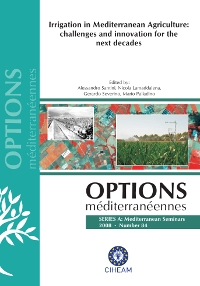| Article précédent | p. 301-310 | Article suivant |
Hydro-salinity balance to monitor soil salinity at field scale due to brackish irrigation water
The aim of the trial was to detect the risk of soil salinity due to brackish irrigation. A permanent experimental field-unit was established in autumn 2006; three plots were delimited; at the center of each plot an artificial draining basin was arranged digging the soil out of a trench; the bottom of each trench was covered with a plastic sheet in order to prevent water percolation; a set of drains were displaced over the plastic cover to collect the percolating water and conveying it into tanks placed at the edge of each plot. The trenches were then filled with the same soil obtained by the excavating procedure. The electrical conductivity of the irrigation water (ECi) increased from 4.7 to 5.3 dS m-1 along the crop cycle. Soil ECe (electrical conductivity of soil saturated water extract) was periodically measured by soil samplings. Seasonal farmer irrigation was 544 mm while rain amounts were equal to 117 mm. Along the crop cycle, an increasing soil salinization occurred, starting from 2.4 dS m-1 up to 6.6 dS m-1. Due to leaching, at harvest, the soil ECe decreased to 4.8 dS m-1. Approximately, a 25 percent of yield reduction was recorded as compared to contiguous field irrigated with good water quality. A leaching fraction of approximately 10 percent resulted from the water balance while almost 20 percent of salt was removed from the soil profile with respect to the salt load bring about with irrigation. That means an actual leaching efficiency of approximately 220 kg ha-1 per each percent point of leached water.
Le but de cet essai est de détecter le risque de formation de salinité du sol par l'utilisation d'eau saumâtre pour l'irrigation. Un champ expérimental (Sud de l'Italie) permanent a été établi en automne 2006; trois parcelles ont été délimitées au centre desquelles un bassin de drainage artificiel a été construit. Le fond de chaque tranchée a été couvert de feuilles de plastique pour prévenir l'infiltration d'eau et un ensemble d'égouts a été installé sur l'abri en plastique pour récupérer l'eau stagnante et l'évacuer par des canaux situés au bord de chaque parcelle. Les tranchées ont été remplies du même sol obtenu par excavation. La conductivité électrique (CE) de l'eau d'irrigation a augmenté de 4.7 jusqu'à 5.3 dS m-1 et l'ECe du sol a été périodiquement mesurée. L'approvisionnement en eau d'irrigation totale était de 661 mm (544 mm d'eau d'irrigation et 117 mm d'origine pluviale). La salinité du sol a augmenté au fur et à mesure du cycle de la culture (tomates), de 2.4 dS m-1 jusqu'à 6.6 dS m-1. A cause du lessivage et pendant la récolte, l'Ece du sol, a diminué de 4.8 dS m-1. Le rendement a baissé de 25 pour cent par rapport à un champ adjacent irrigué avec de l'eau de bonne qualité. 10 pour cent environ du lessivage est dû à l'équilibre hydrique tandis que 20 pour cent des sels ont été éliminés du profil du sol par rapport au sel apporté par l'eau d'irrigation. Ce qui implique un lessivage réel d'environ 220 kg ha-1.
- [ Afficher ]
- [ Télécharger ]
- [ Exporter la citation ]
Vous pouvez télécharger la citation au format :
- [ Imprimer ]
-
Mots-clés
BILAN HYDRIQUE DU SOL, EAU DE DRAINAGE, EAU D'IRRIGATION, EAU SAUMATRE, LESSIVAGE DU SOL, SALINITE DU SOL, SELCiter cet article
Libutti A., Florio M., Monteleone M., Disciglio G., Tarantino E. Hydro-salinity balance to monitor soil salinity at field scale due to brackish irrigation water. In : Santini A. (ed.), Lamaddalena N. (ed.), Severino G. (ed.), Palladino M. (ed.). Irrigation in Mediterranean agriculture: challenges and innovation for the next decades. Bari : CIHEAM, 2008. p. 301-310. (Options Méditerranéennes : Série A. Séminaires Méditerranéens; n. 84). International Conference on Irrigation in Mediterranean Agriculture: Challenges and Innovation for the Next Decades, 2008/06/17-18, Naples (Italy). http://om.ciheam.org/om/pdf/a84/00800977.pdf



